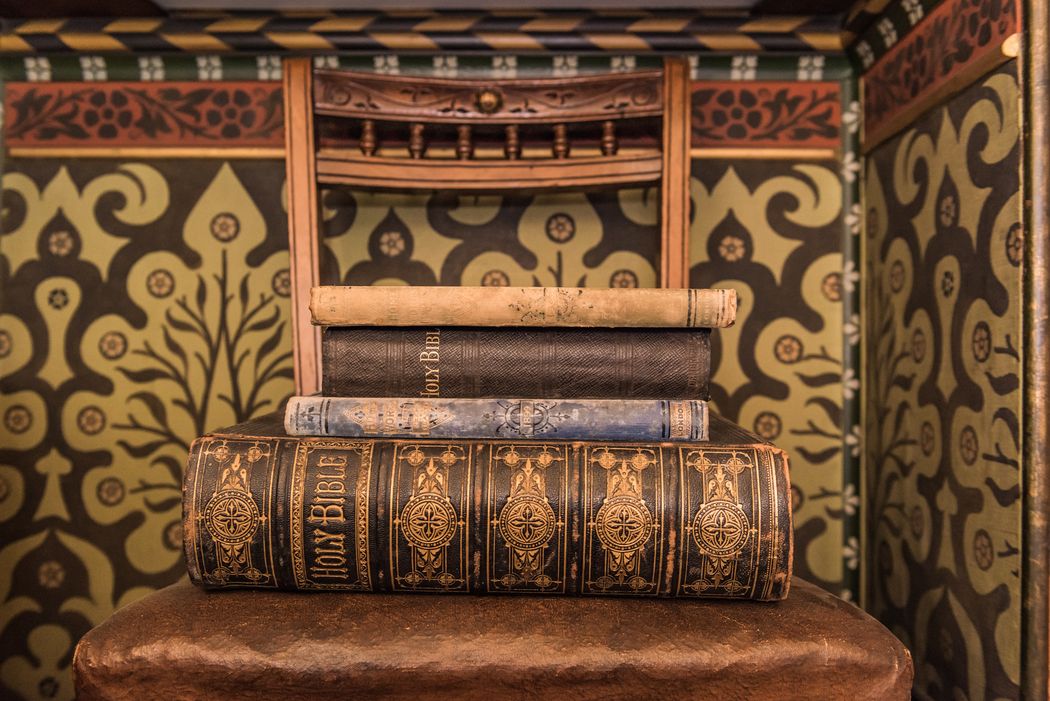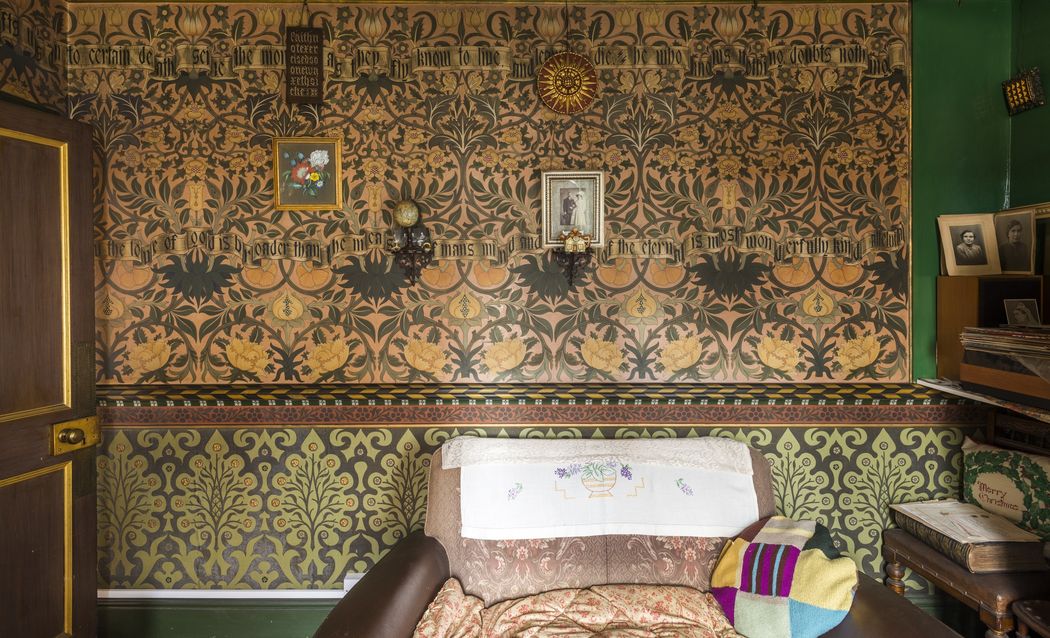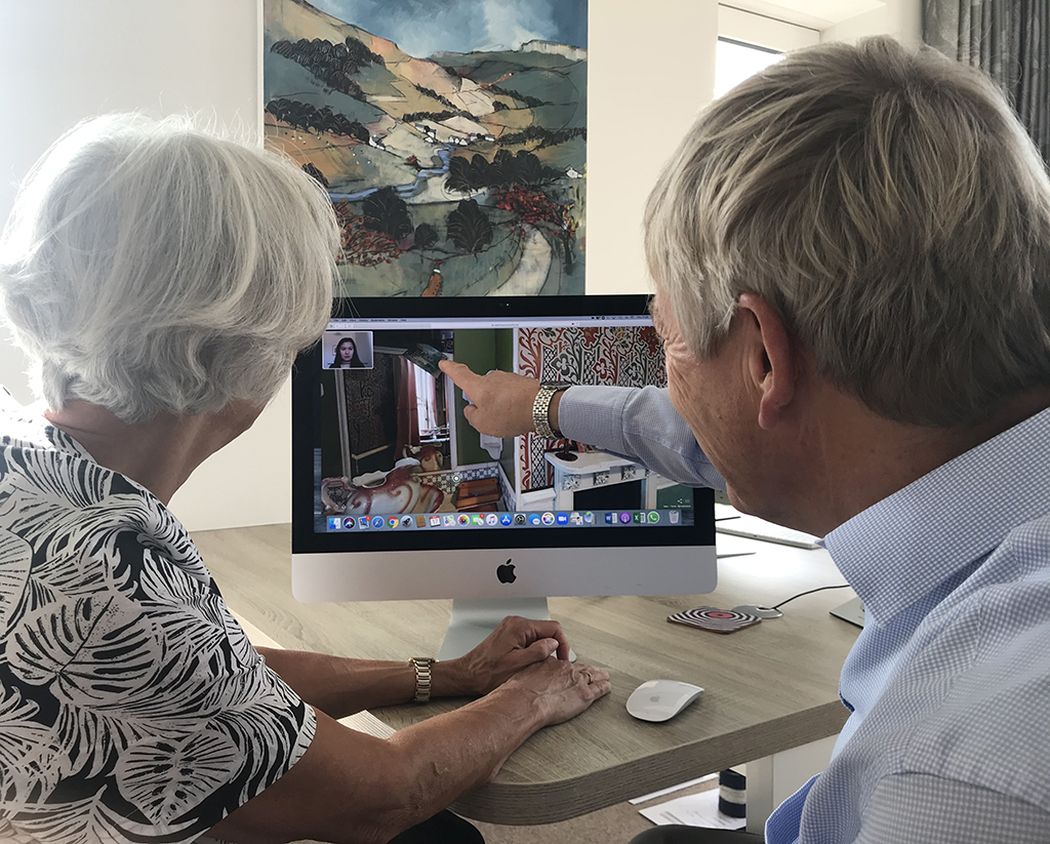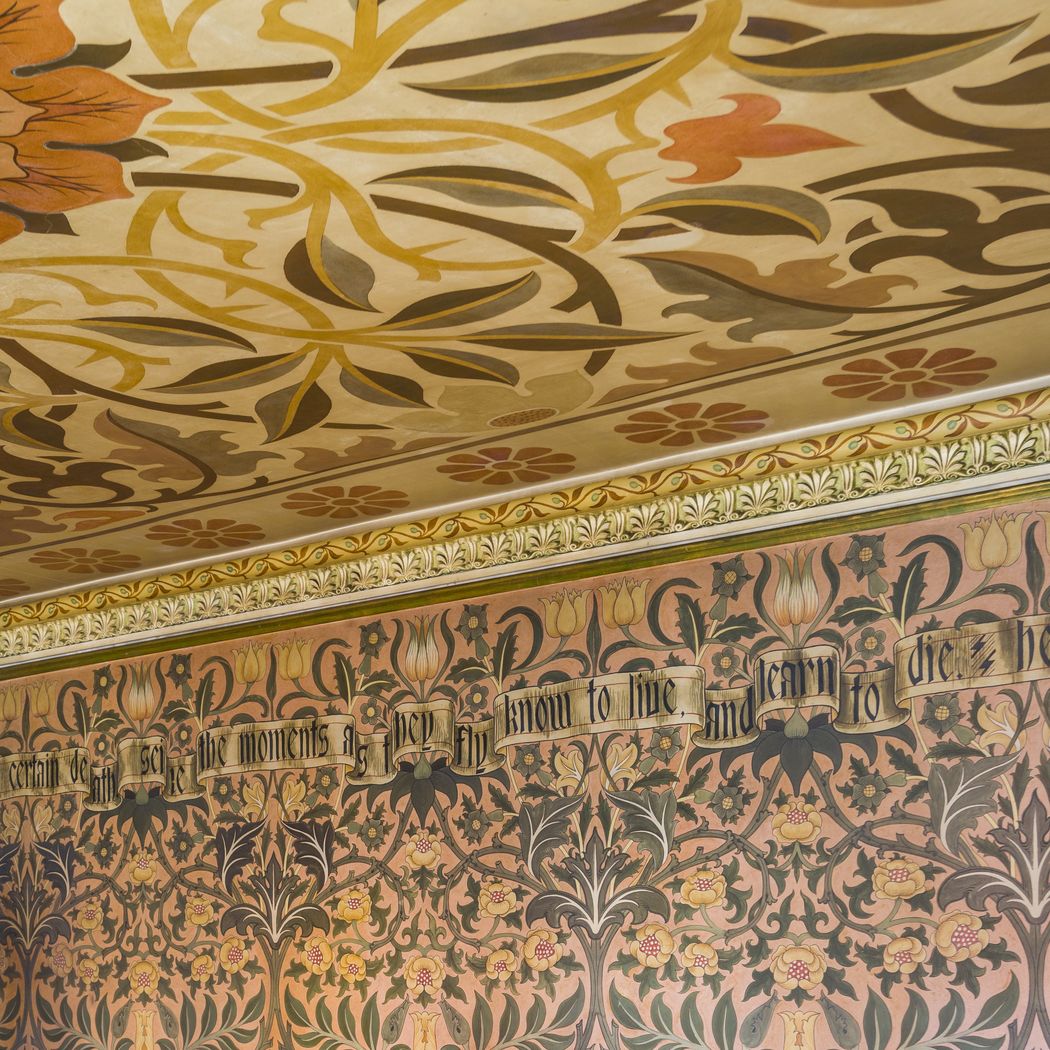“The virtual tour is here to stay”
An interview with Charlotte Woodley, Pilgrim Trust Curator of the David Parr House
The David Parr House in Cambridge looks like an ordinary terraced house from the outside … but once you enter, you discover that this space is far from it. Decorated head to toe by working class painter David Parr, the house was carefully kept by the artist's granddaughter Elise Palmer whose life and belongings are now preserved alongside the artist's work in a time capsule like no other. Here network co-ordinator Molly Skinner talks with Charlotte Woodley, Pilgrim Trust Curator of the David Parr House, about how this special space has stayed open virtually during closures and a unique virtual tour delivered live by volunteers.
_
Molly Skinner, ASMN Co-ordinator: What did the museum have planned for 2020 pre-covid - what was the year supposed to look like?
Charlotte Woodley, Pilgrim Trust Curator: This was going to be our second season of fully booked tours. We were closed for two and a half years for conservation and we reopened in 2019. So we were actually fully booked for this season and we were selling out of tickets with each batch released really quickly. We had a waiting list of several hundred would-be visitors. We were expecting quite a sort of bedding in a year, a year of consolidation, so we could learn from last year's first season of tours.
We also had events booked for the entire year because we were fundraising for an endowment that ends in May 2021. It's a match funded campaign, so every contribution is doubled by the National Heritage Lottery Fund. So we had planned an amazing year of physical events - it was quite heartbreaking to cancel everybody's tours. Gradually as time went by, we realised that we had to stop all of those booked events as well.
_
“It was quite heartbreaking to cancel everybody's tours"
_
That was quite difficult, our three main concerns were: how to replace the revenue from our physical tours, how to engage with our audience over this period and how to keep our very loyal and passionate volunteer house guides involved. Our volunteer guides do all of the tours for us and many of them fall into quite a vulnerable demographic. We do feel that they're very much part of our David Parr House extended family so engaging with them was a main concern.

M: Were you able to adapt any of your work with your volunteers and with the house or was it more a case of biding your time?
C: After we cancelled everything we then started to have a look at what we could do instead. In April we applied to the arts council emergency fund and we received a grant from them to fund an online engagement programme which we called 'behind closed doors'. We started quite quickly in April talking to the volunteers because we found it was a really good way of engaging with them and we had a few zoom workshops and talks that we trialled with them. It was actually quite difficult to get some of them on zoom in the beginning as some of them were quite resistant to it.
But we did it and we did the first trial talk in May and by the end of May we started doing online Zoom talks - we've now been doing online zoom talks most months since then as a public zoom talk which has been really interesting. We offered those via a donation because we thought it was a difficult time to ask people for money. With a donation people can be flexible about what they donate. But they were really popular and we are going to continue doing those. We've had some great talks actually, really good quality and we've capped the numbers at 100 for each of those talks. We've found you can retain a personal element to them if you keep them not too unwieldy.
_
“For talks on specialist subjects we can struggle sometimes in a local environment: booking a physical place, getting the volunteers, the cost involved and even setting out the chairs! You can kind of navigate all of those things with Zoom talks”
_
We also had an online exhibition in May that ran until June called 'A Space of One's Own' which was a really interesting exhibition examining private spaces and how you use them which chimed really well with our current situation, especially during lockdown when everyone was very much focused on their homes. We even held a competition that ran alongside it where people could contribute their own spaces that was judged by Laurence Llewellyn-Bowen.
We've found the response to the digital really interesting. For talks on specialist subjects we can struggle sometimes in a local environment: booking a physical place, getting the volunteers, the cost involved and even setting out the chairs! You can kind of navigate all of those things with Zoom talks. The other thing we found interesting was that we found people really liked to see photographs and documents on the screen where they can examine them quite close up for themselves. I really am excited by zoom talks now, I think they're the way forward!

M: I think lots of people would agree with you and lots of people would disagree ... I think everyone's tired of sharing their screen this year! But I think it's been a lesson in accessibility in some cases - discovering not only how to stay connected with your current audience online but working with audiences who were potentially excluded before and can suddenly now access all of this amazing content.
C: It makes a huge difference, I think it will always have a place. Obviously we want to return to physical tours and physical events but it does mean that people can be included from wherever they are which makes a big difference. Which then kind of led us on to thinking about doing an online virtual tour and that's been the biggest thing that we've been working on this year.
We applied for a grant from Historic England and that was back in May to develop a virtual tour. The virtual tour is something that we kind of were thinking about doing three or four years down the line because we were about to develop more physical tours. But we were almost forced into thinking about a virtual tour sooner. When I was talking to companies, I got quite excited because I understood suddenly that we could offer a personal guided online 3D tour which made a huge amount of difference to us because our physical tours are so special because they're done by the volunteer house guides.
_
“Each of the guides has their own perspective and has been encouraged to do the tour their way and highlight their own interests and passions”
_
Each of the guides has their own perspective and has been encouraged to do the tour their way and highlight their own interests and passions. So this has been a way for us to use our wonderful guides and means that they could do this tour from anywhere to anyone.
The David Parr House is a very small confined and fragile environment so we were always restricted in our visitor numbers. We can only take round small groups and our season runs from February to November because it gets quite cold in the house as there's no central heating. This has also meant that people with mobility issues who couldn't get up the stairs can now access that. It's exciting because it means that people with mobility issues can visit, people from around the world can visit - international visitors that we would never have dreamt of are suddenly able to experience the David Parr house. Also we don't have access for children under 12 because it's such a tight delicate environment - so it means that access for our local community and for our international audience is increased and that's quite exciting. The virtual tour is here to stay forever for those reasons.
When people book a tour they get an email with links and the first link takes them to their online guided tour which takes about an hour. We have a house guide and a steward who take them through the virtual environment and then after that hour they then have access through a secondary link for the rest of the day to explore the platform which is the same virtual environment but filled with 103 hotspots which have got loads of information.
_
“Nothing can replace being in the David Parr house and nothing can replace the atmosphere but the virtual tour gives people a way to experience the house in a different way”
_
One of the really exciting things is that we had lots of audio and video that we had collected throughout the conservation phase and while we were building up to reopening the house. So it's given us a really wonderful platform in which to put these resources in a context so you can see videos of the conservation of the house and you can actually see the 3D environment so the results of that conservation.
The house underwent a huge amount of conservation which you wouldn't actually realise when you visit the house because it's been so carefully done. So that's really interesting - being able to show people the conservation in a much more engaging and open way - you can actually see the sash windows coming out and being put back in!
We also collected a lot of audio memories - it's really lovely because you can listen to Elsie, David Parr's granddaughter, in the dining room talking about her grandfather's work. If you click on the kitchen table you can listen to Janet, one of her neighbours, talk about her as a person and how she used to sit at that table and chat with Elsie. Everything takes on so much more resonance when you kind of see it within a context.
Before they were sort of buried on our website but this way it brings it to life. It's very exciting, I've got very excited and I got very passionate about it when I realised the capabilities of it and the positives. Obviously there's downsides because nothing can replace being in the David Parr house and nothing can replace the atmosphere and the smell and those kinds of things but the virtual tour does give a way of people being able to experience the house in quite a different way. When they scanned the rooms they used the camera in various different spots so you can actually stand on the armchair in the drawing room and examine the friezes close up! So I think one of the things that we're trying to do is see the positives, the benefits of it.

M: I think that kind of challenge is something that lots of studio museums face with a preserved space: how do you bring in that extra material without either disturbing the space or changing it with physical interventions? It sounds like a really interesting way of doing that and it's really exciting to think about continuing that alongside physical tours - have you been planning for a physical reopening?
C: I think it's really difficult at the moment because you don't really know what the future is going to be. Ideally we would open up the physical tours next year at the beginning of the season but I don't think it's going to be possible to open up completely in the same way. What we have done is recorded a new version of the guided tour. We had 11 of our wonderful house guides volunteer to take part in the audio tour alongside three team members, which means the tour has 14 unique voices. We recorded our normal physical tour in sections, so each person took a section they were interested in and passionate about it and rewrote it in their own voice. That is an audio tour that we could deliver socially distanced for next season so that people could come in small groups.
_
“I think like most organisations it's about feeling your way and reacting to what happens”
_
We're trying to build a bit of a toolkit for next year to give us options. I think like most organisations it's about feeling your way and reacting to what happens. But the virtual online 3D tour will always have a place even when people might come for physical tours - it could even be something people take away from the experience as an add-on to their physical tour.
M: It makes me think of the kind of differences in capacity you can achieve with this as well, you could take school groups for instance, where as before because you're in a terraced house you couldn't possibly have that many people in the space.
C: Yes definitely, it means that we will also be able to do some digital work in the community as well. We're now starting to see lots of people asking to visit as a group experience where they could take the tour together. So they could join as a group from all over the world and have a shared experience.
M: That's so exciting!
C: It is really exciting. The guides have been amazing but it's been a real challenge. It's completely new technology that they've never had to use before and some of them are in the older demographic so I've been really proud of them because they've really taken it on board. We had 21 house guides doing physical tours and 18 of them are doing the online tours for us now. There's a lot of fear involved in getting over the first few ones but they're actually really enjoying it and I'm hoping that as time goes by it becomes something that everyone really enjoys doing.
I think digital is becoming normalised and people are getting more used to it and it's been interesting to see the feedback from the past couple of weeks from visitors. We've sent out feedback forms and the feedback that we're getting is that everybody is satisfied with the tours, that they would recommend them. A lot of them are people that have never visited the David Parr House before and a lot of them are in a much older demographic and they have been finding the technology easy to use and that has all been really interesting.

M: That is really interesting - do you think being a studio museum has affected how you've handled the last year and how you tackle reopening?
C: I think like a lot of Studio Museum organisations we're quite small in size. Size has a huge impact on what you feel you can achieve - if you've got a much bigger environment it is so much easier to do more social distancing. I think one of the challenges is finding ways that people can experience the house safely. Being part of the network is really interesting as well because now we have something that we can offer to people much further away, we can connect to other people and make virtual partnerships with other museums which would be a really interesting thing to do.
M: It would definitely be really exciting to connect the museums in the network more, looking ahead how do you imagine your museum experience changing? It sounds like in your digital tours you've been able to preserve the intimacy of your physical tours.
C: That was one of the primary concerns - we wanted to make something that still had that personal element to it. One of the things we found with the physical tours in the feedback was mention of it always being a very personal experience and about that feeling of home.
It was amazing actually as you'd watch people start off in the visitor centre and maybe be a little bit standoffish and unsure about what they were about to experience and they would come back filled with emotion because it is one of those places that does get your heart. It is a family home as well as an extraordinary example of David Parr's work.
_
“You'd watch people start off in the visitor centre and maybe be a little bit standoffish and unsure about what they were about to experience and they would come back filled with emotion”
_
It tugs at people's heart strings and memories so it was important for us to retain that personal connection. For the virtual tours the groups are similarly sized to the physical tours so that it enables a conversation with the visitors. They can be welcomed and actually have a personal experience with other human beings which I think is really important at the moment. The other thing that we've been thinking about is how to create other experiences based on the audio. The personal aspects of the virtual tour are what people are finding most enjoyable -it's thinking about how to introduce new stories to that digital realm.
M: My last question is really what are you most excited about looking at the year ahead? It seems like it's a continuation of this project.
C: Yes, it's only at the beginning! We're only in our third week of virtual tours at the moment and we've marketed it as an introductory trial because we wanted to see how people responded to it. So we could think about what we could do to improve it, see how our volunteers would cope with it - whether it was manageable, what kind of times of the day are best. All of those sorts of things.
One of the most challenging aspects to communicate is that the virtual tours do have to make money for us in order to sustain the organisation, this can be hard to market as so much digital in culture is given away for free, but there is a cost in creating & maintaining that needs to be reflected to the public. It has been about producing a quality, highly personal experience that is worth money and we want to find ways to communicate that effectively through marketing, nationally and internationally
It's a big learning process so I very much see next year as learning from those findings and developing the digital further and hopefully being able to reintroduce physical tours and events a bit later on in the year because we do still have a deadline of next year to raise the money for the endowment. So we need to raise half a million which will be match funded to raise a million pound endowment. We're at 400 thousand now so next year will be quite a busy year for us fundraising to achieve that goal. So trying to combine digital with physical with fundraising should make it quite an exciting year!
Charlotte Woodley is the Pilgrim Trust Curator of the David Parr House in Cambridge.
Discover more about the David Parr House: https://www.artiststudiomuseum.org/studio-museums/...
Book a guided virtual tour: https://www.artiststudiomuseum.org/exhibitions/vir...
Donate to support the David Parr House: https://davidparrhouse.org/product/donation
